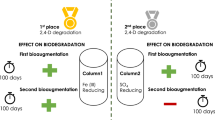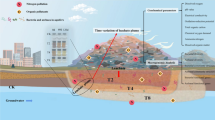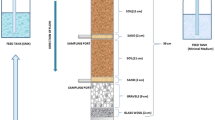Abstract
This study was performed to reveal the microbial community characteristics in simulated managed aquifer recharge (MAR), a natural water treatment system, under different concentrations and compositions of biodegradable dissolved organic carbon (BDOC) and further link these to the biotransformation of emerging trace organic chemicals (TOrCs). Two pairs of soil-column setups were established in the laboratory receiving synthetic feed solutions composed of different peptone/humic acid ratios and concentrations. Higher BDOC concentration resulted in lower microbial community diversity and higher relative abundance of Betaproteobacteria. Decreasing the peptone/humic acid ratio resulted in higher diversity of the community and higher relative abundances of Firmicutes, Planctomycetes, and Actinobacteria. The metabolic capabilities of microbiome involved in xenobiotics biodegradation were significantly promoted under lower BDOC concentration and higher humic acid content. Cytochrome P450 genes were also more abundant under these primary substrate conditions. Lower peptone/humic acid ratios also promoted the attenuation of most TOrCs. These results suggest that the primary substrate characterized by a more refractory character could increase the relative abundances of Firmicutes, Planctomycetes, and Actinobacteria, as well as associated cytochrome P450 genes, all of which should play important roles in the biotransformation of TOrCs in this natural treatment system.




Similar content being viewed by others
References
Alidina M, Li D, Ouf M, Drewes JE Role of primary substrate composition and concentration on attenuation of trace organic chemicals in managed aquifer recharge systems. J Environ Management (in review)
Amy G, Drewes JE (2007) Soil aquifer treatment (SAT) as a natural and sustainable wastewater reclamation/reuse technology: fate of wastewater effluent organic matter (EfOM) and trace organic compounds. Environ Monit Assess 129:19–26
Barnes KK, Kolpin DW, Furlong ET, Zaugg SD, Meyer MT, Barber LB (2008) A national reconnaissance of pharmaceuticals and other organic wastewater contaminants in the United States—I. Groundwater. Sci Total Environ 402:192–200
Benotti MJ, Trenholm RA, Vanderford BJ, Holady JC, Stanford BD, Snyder SA (2009) Pharmaceuticals and endocrine disrupting compounds in US drinking water. Environ Sci Technol 43:597–603
Buerge IJ, Buser H-R, Kahle M, Müller MD, Poiger T (2009) Ubiquitous occurrence of the artificial sweetener acesulfame in the aquatic environment: an ideal chemical marker of domestic wastewater in groundwater. Environ Sci Technol 43:4381–4385
Caporaso JG, Kuczynski J, Stombaugh J, Bittinger K, Bushman FD, Costello EK (2010) QIIME allows analysis of high-throughput community sequencing data. Nat Methods 7:335–336
Dantas G, Sommer MOA, Oluwasegun RD, Church GM (2008) Bacteria subsisting on antibiotics. Science 320:100–103
Dillon P (2005) Future management of aquifer recharge. Hydrogeol J 13:313–316
Drewes JE, Fox P (1999) Fate of natural organic matter (NOM) during groundwater recharge using reclaimed water. Water Sci Technol 40:241–248
Gao J, Ellis LBM, Wackett LP (2010) The University of Minnesota biocatalysis/biodegradation database: improving public access. Nucleic Acids Res 38:D488–D491
Golan-Rozen N, Chefetz B, Ben-Ari J, Geva J, Hadar Y (2011) Transformation of the recalcitrant pharmaceutical compound carbamazepine by Pleurotus ostreatus: role of cytochrome P450 monooxygenase and manganese peroxidase. Environ Sci Technol 45:6800–6805
Halden RU (2010) Introduction to contaminants of emerging concern in the environment: ecological and human health considerations. Contaminants of emerging concern in the environment: ecological and human health considerations. ACS Symp Ser 1048:1–6
Hammer Ø, Harper DAT, Ryan PD (2001) Past: paleontological statistics software package for education and data analysis. Palaeontol Electron 4:e1–e9
Heberer T (2002) Occurrence, fate, and removal of pharmaceutical residues in the aquatic environment: a review of recent research data. Toxicol Lett 131:5–17
Helbling DE, Hollender J, Kohler HP, Singer H, Fenner K (2010) High-throughput identification of microbial transformation products of organic micropollutants. Environ Sci Technol 44:6621–6627
Jenkins O, Byrom D, Jones D (1987) Methylophilus: a new genus of methanol-utilizing bacteria. Int J Syst Bacteriol 37:446–448
Jones OAH, Green PG, Voulvoulis N, Lester JN (2007) Questioning the excessive use of advanced treatment to remove organic micropollutants from wastewater. Environ Sci Technol 41:5085–5089
Kolpin DW, Furlong ET, Meyer MT, Thurman EM, Zaugg SD, Barber LB, Buxton HT (2002) Pharmaceuticals, hormones, and other organic wastewater contaminants in U.S. streams, 1999–2000: a national reconnaissance. Environ Sci Technol 36:1202–1211
Li D, Sharp JO, Saikaly PE, Ali S, Alidina M, Alarawi MS, Keller S, Hoppe-Jones C, Drewes JE (2012) Dissolved organic carbon influences microbial community composition and diversity in managed aquifer recharge systems. Appl Environ Microbiol 78:6819–6828
Li D, Alidina M, Ouf M, Sharp JO, Saikaly PE, Drewes JE (2013) Microbial community evolution during simulated managed aquifer recharge in response to different biodegradable dissolved organic carbon (BDOC) concentrations. Water Res 47:2421–2430
Madyastha KM, Sridhar GR, Vadiraja BB, Madhavi YS (1999) Purification and partial characterization of caffeine oxidase—a novel enzyme from a mixed culture consortium. Biochem Biophys Res Commun 263:460–464
Maeng SK, Sharma SK, Lekkerkerker-Teunissen K, Amy GL (2011) Occurrence and fate of bulk organic matter and pharmaceutically active compounds in managed aquifer recharge: a review. Water Res 45:3015–33
Mazzafera P (2004) Catabolism of caffeine in plants and microorganisms. Front Biosci 9:1348–1359
Missimer TM, Drewes JE, Maliva RG, Amy G (2011) Aquifer recharge and recovery: groundwater recharge systems for treatment, storage, and water reclamation. Ground Water 49:771
Ogunseitan OA (2002) Caffeine-inducible enzyme activity in Pseudomonas putida ATCC 700097. World J Microb Biot 18:423–428
Onesios KM, Bouwer EJ (2012) Biological removal of pharmaceuticals and personal care products during laboratory soil aquifer treatment simulation with different primary substrate concentrations. Water Res 46:2365–2375
Ortiz De Montellano PR, De Voss JJ (2005) Substrate oxidation by cytochrome P450 enzymes. In: Ortiz De Montellano PR (ed) Cytochrome P450: structure, mechanism, and biochemistry. Plenum, New York, pp 183–245
Prior JE, Shokati T, Christians U, Gill RT (2010) Identification and characterization of a bacterial cytochrome P450 for the metabolism of diclofenac. Appl Microbiol Biotechnol 85:625–633
Rauch-Williams T, Hoppe-Jones C, Drewes JE (2010) The role of organic matter in the removal of emerging trace organic contaminants during managed aquifer recharge. Water Res 44:449–460
Sogorb MA, Vilanova E (2002) Enzymes involved in the detoxification of organophosphorus, carbamate and pyrethroid insecticides through hydrolysis. Toxicol Lett 128:215–228
Wackett LP (2006) The metabolic pathways of biodegradation. In: Dworkin M, Falkow S, Rosenberg E, Schleifer K-H, Stackebrandt E (eds) The prokaryotes, vol 2, 3rd edn. Springer-Verlag, New York, pp 956–968
Westerhoff P, Yoon Y, Snyder S, Wert E (2005) Fate of endocrine-disruptor, pharmaceutical, and personal care product chemicals during simulated drinking water treatment processes. Environ Sci Technol 39:6649–6663
Acknowledgments
This research was supported by discretionary investigator funds at King Abdullah University of Science and Technology (KAUST). The material presented is also based in part upon work supported by the National Science Foundation under Cooperative Agreement EEC-1028968. The authors are thankful for technical assistance provided by Prof. Pascal Saikaly at KAUST as well as Prof. Jonathan O. Sharp at Colorado School of Mines.
Author information
Authors and Affiliations
Corresponding author
Electronic supplementary material
Below is the link to the electronic supplementary material.
ESM 1
(PDF 4358 kb)
Rights and permissions
About this article
Cite this article
Li, D., Alidina, M. & Drewes, J.E. Role of primary substrate composition on microbial community structure and function and trace organic chemical attenuation in managed aquifer recharge systems. Appl Microbiol Biotechnol 98, 5747–5756 (2014). https://doi.org/10.1007/s00253-014-5677-8
Received:
Revised:
Accepted:
Published:
Issue Date:
DOI: https://doi.org/10.1007/s00253-014-5677-8




